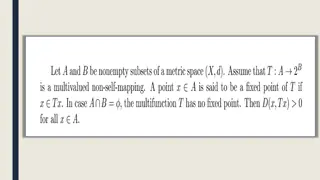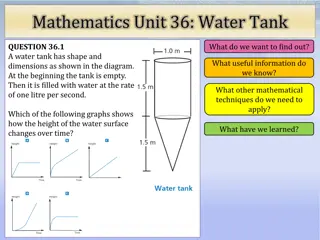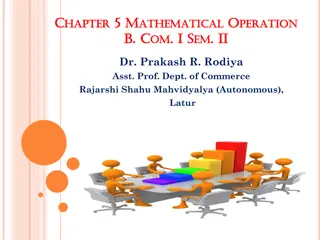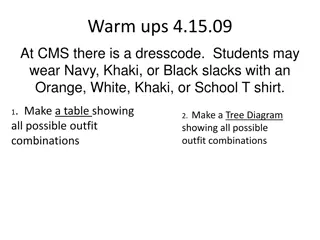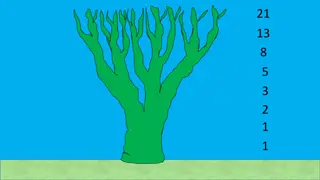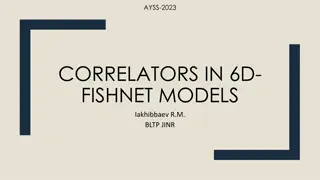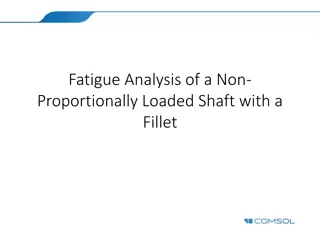Understanding Mathematical Models: Applications and Analysis
Explore the concept of mathematical models through real-world examples such as ball trajectory, animal fat intake and death rates, and cricket chirping rates based on temperature. Different types of models and their implications are discussed, emphasizing the importance of considering various factors for accurate predictions and interpretations.
Download Presentation

Please find below an Image/Link to download the presentation.
The content on the website is provided AS IS for your information and personal use only. It may not be sold, licensed, or shared on other websites without obtaining consent from the author. Download presentation by click this link. If you encounter any issues during the download, it is possible that the publisher has removed the file from their server.
E N D
Presentation Transcript
2.4 Mathematical Models All slides in this presentations are based on the book Functions, Data and Models, S.P. Gordon and F. S Gordon ISBN 978-0-88385-767-0
What is a Math Model A simplified version of the real phenomenon/ process that captures realistically its most important characteristics A ball thrown vertically from ground level ? = ? ? = 64? 16?2 What does this model describe? Often math models are expressed as functions p. 2
Avg. daily intake of animal fats and death rates from breast cancer in different countries D = 0.2F 1 is the mathematical model of this example The avg. daily animal fat intake in Mexico is F = 23 grams and that in Denmark is F = 135 grams. What can you say about the death rate in these countries? p. 3
Avg. daily intake of animal fats and death rates from breast cancer in different countries D = 0.2F 1 is the mathematical model of this example The avg. daily animal fat intake in Mexico is F = 23 grams and that in Denmark is F = 135 grams. What can you say about the death rate in these countries? ? = 0.2 23 1 = 3.6 ???? ? ??? 100,000 ????? ?? ?????o ? = 0.2 135 1 = 26 ???? ? ??? 100,000 ????? ?? ??????? p. 4
Avg. daily intake of animal fats and death rates from breast cancer in different countries The prediction in Mexico is called interpolation since 23 is between 20 and 120 (values of F in the data set) The prediction in Denmark is called extrapolation since 135 is outside of the data range, 20 to 120 It is more realistic to assume that the incidence of breast cancer depends on many other factors in combination with animal fat intake. This leads to a function of several variables outside the scope of our course. p. 5
Snowy Tree Cricket in Colorado Rockies Data relating cricket s rate of chirping, in chirps per minute, and air temperature in degrees Fahrenheit. Which is the dependent variable? Which is the independent one? p. 6
Snowy Tree Cricket in Colorado Rockies Data relating cricket s rate of chirping, in chirps per minute, and air temperature in degrees Fahrenheit. Which is the dependent variable? Which is the independent one? R is the dependent variable T is the independent variable Want to visualize the data. Use it to predict R when the temperature is 82 degrees. p. 7
Graph of the model; Formula y = 4x - 160 Rate of chirps versus temperature 180 160 140 120 100 80 60 40 20 0 50 55 60 65 70 75 80 85 p. 8
Cricket chirps continued Every 5 degrees increase in the temperature lead to an increase of 20 chirps per minute A 1 degree increase in temperature would lead to an increase of how many chirps per minute? We see that R(80)=160 so at 82 degrees there is an increase of 2 degrees or 2(4)=8 chirps per minute; therefore R(82)=160 + 8=168 p. 9
Parameters and Mathematical Models An object dropped from the 180 foot - tall tower of Pisa ? ? = 180 16?2 An object dropped from the 555 foot - high Washington monument ? ? = 555 16?2 An object dropped from the 1821 foot - high CN tower in Toronto ? ? = 1821 16?2 Note: ? ? = ?0 16?2in general, where ?0is the initial height ?0is NOT a variable; it is called a parameter of the model p. 10
Example 2 - Parameters Drive steadily at 60 miles per hour ? = 60? Drive steadily at 75 miles per hour ? = 75? Drive steadily at 50 miles per hour ? = 50? We notice that in general ? = ? ? where s is the steady speed at which is driven S is a parameter for this model/formula. p. 11









